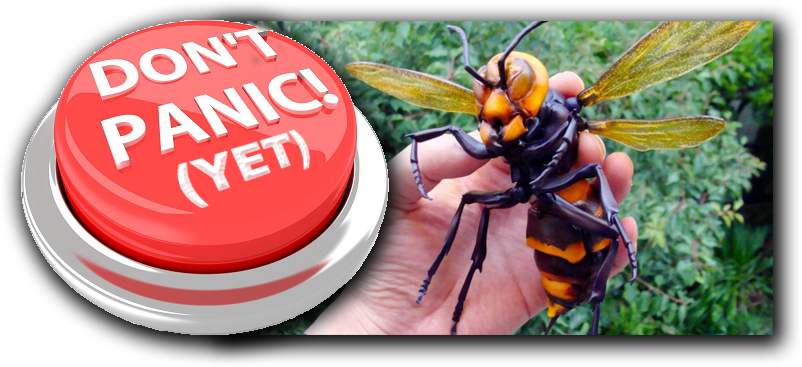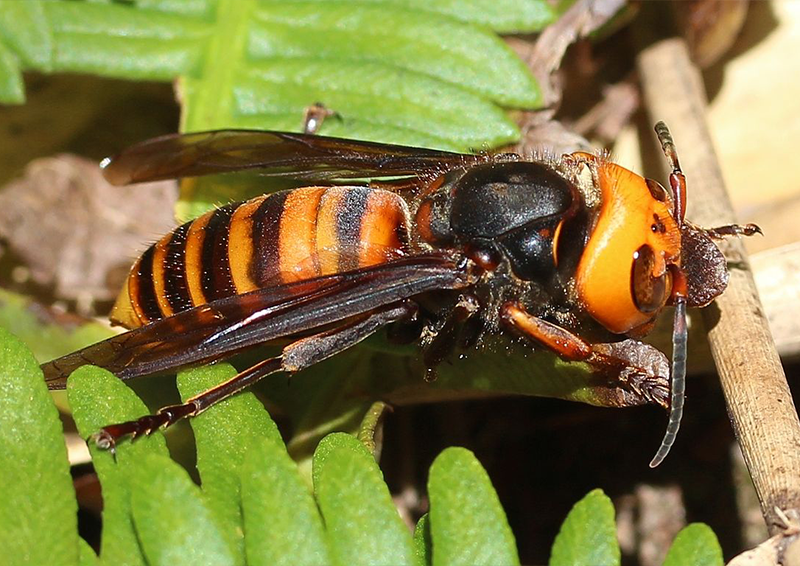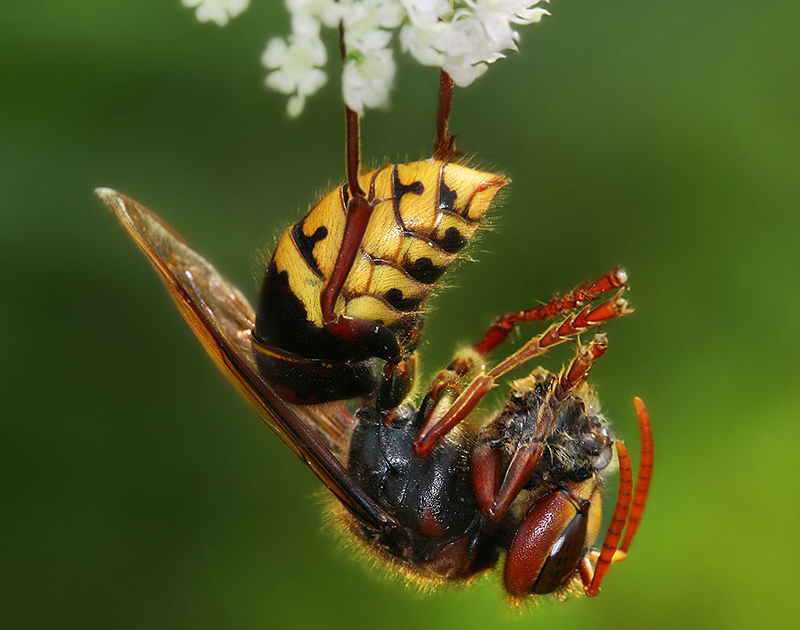
Giant Asian Murder Hornets? Oh My!

As if we needed more bad news, it was widely reported over the last few days that beekeepers have another potentially devastating plague
to worry us. Oh, 2020, can we just get a break?
Already anxious over the worldwide COVID-19 virus pandemic, beekeepers learned recently that a deadly honey bee virus known as IAPV (Israeli Acute Paralysis Virus) is even craftier than we believed. Researchers recently announced that this pathogen, which had been implicated early on as a factor in colony collapse disorder (CCD), has figured out how to sneak into healthy hives in a veritable Trojan Horse move. That was bad news for a struggling industry that continues to reel from average colony losses of 30% or worse every year for over a decade.
And then, of course, another shoe dropped.
Now we are ordered to begin worrying about the pleasantly named Giant Asian Murder Hornet. The world's largest hornet, they are officially known as Vespa mandarinia, and are native to temperate and tropical eastern Asia. They can be found as far north as eastern Russia, down to southeast Asia and into India, as well as in Japan. These big bad bugs were first confirmed near the town of Nanaimo, on Vacouver Island, British Colombia, and later near the border town of Blaine, in Washington state late last year. Now they are becoming active again with warming spring temperatures. Lucky us.
While they made bold headlines over the past weekend, many beekeepers have long been aware of this potential threat to their livelihoods thanks to cinematic footage that has been circulating online for years. You can watch a videopurporting to show 30 Asian Hornets completing devastating a hive of 30,000 honey bees, although this video does not give any source information about who filmed it, or when or where.
Before you become too alarmed by the carefully photographed specimens that can appear as big as the hand holding them, these insects have not been found anywhere close to Arkansas yet. We are already familiar with the introduced European hornet species, Vespa crabro. These can be fierce, but typically avoid humans as long as they are not provoked. We have already had numerous panicked reports from across the state, from vigilant homeowners and beekeeper, absolutely sure that they have spotted the new ones they just heard about yesterday.
What we are likely seeing right now are V. crabro queens. These are large insects that overwinter alone, and must start a new nest
by themselves in the spring. Once they establish a nest and raise some offspring,
they stay home to lay eggs and let their daughters gather all the food. Bumble bees,
paper wasps and yellow jackets have a similar strategy. The colony will grow throughout
the summer, and new queens will be created in the fall. The rest of the colony usually
dies out in winter, while those new queens hibernate and come out again next year.
Don't confuse the two species, pictured below. Their markings are distinct.

Giant Asian Hornet Vespa mandarinia (photo by Alpsdake, courtesy Wikipedia Commons). Note the distinct, broad black bands around the abdomen.
 European hornet Vespa crabro feeding on a honey bee (photo by Richard Bartz, Munich aka Makro Freak - Own work,
courtesy Wikipedia Commons). Note the irregularly shaped black bands on the abdomen.
European hornet Vespa crabro feeding on a honey bee (photo by Richard Bartz, Munich aka Makro Freak - Own work,
courtesy Wikipedia Commons). Note the irregularly shaped black bands on the abdomen.
Another species of Asian Hornet, Vespa velutina, has been spreading across Europe for several years, after accidentally being introduced
to France from China in a shipment of plant pots. They have spread rapidly, and have
been responsible for several human deaths there, according to a BBC report. But they remain a greater threat to the European honey bee population than to people.
And now we have Murder Hornets on the West Coast. V. mandarinia reportedly prefer living in low mountain areas and forest habitats, while almost completely avoiding open plains and high altitude climates. This is good news, since there are a few high mountains and a very vast plain separating Arkansas from Washington state. We would like to think these will remain great barriers to the natural migration of the introduced hornets. Of course, the Pacific Ocean should have been a pretty good barrier too. But the usual suspects - people - are responsible for the unwitting movement of many species, which often become invasive pests in new lands. It may only be a matter of time before this hornet is also attracted to the beauty of the Natural State.
What do we need to know, as beekeepers and citizens? First, we in Arkansas are all too familiar with wasps and hornets and yellow jackets. Use common sense to avoid them. Vigilantly remove or kill small nests as soon as they are spotted near your home, before they can grow large. While there will always be a few of those folks who can't help throwing a rock at a wasp nest on purpose, they generally ignore us unless provoked (the hornets, that is, there's no accounting for some people). Also, most wasp species actually provide immense ecological services as pollinators and providers of natural biological control of other pests.
Hornets do attack honey bee colonies in two ways. Individual hornets of multiple species, including the ones already found here in Arkansas, may hover near the entrance of a bee hive, waiting for a weary forager to return. They perform a maneuver called "hawking" where they will swoop in, like a bird of prey, and nab a tired honey bee, quickly decapitating it with their powerful mandibles, and fly off with its headless corpse, to feed the larvae in their own nest (see this in slow motion). Once members of a hornets' nest learn where to find plentiful food, they may return often to this hunting ground in large numbers. While this is unfortunate for the honey bees, remember that a queen bee can reproduce at an astounding rate of more than 1000 eggs per day. It's likely that a colony has over 1000 bees dying of old age every day, so losing a handful more to hungry predators doesn't usually devastate the colony. But this is where the giant Asian hornets differ.
V. mandarinia hornets will scout out an area, and once they find a potentially rich hive, they will mark it with a special signal. They secrete a chemical pheromone that other hornets recognize, and spread it on or near the hive structure itself. They go home to their nest to recruit others, and return in a large horde, able to zero in on the marked hive, and wreak their devastating havoc, potentially decimating the bee colony in short work. This notorious behavior is what has U.S. beekeepers concerned.
Because the hornets are so large, it may be possible to physically exclude these monsters from entering a bee hive by securing the entrance with a screen that allows bees to pass, but prevents hornets from entering. While this may protect the hive itself, it cannot stop hornets from preying on individual forager bees outside the hive. Also, retrofitting a protective gateway to every hive in giant commercial beekeeping operations will be an expensive and time consuming undertaking. I suspect numerous clever beekeepers are already in their workshops, crafting various prototypes.
Honey bees themselves may prove to be their own best defense. Different groups of bees in Asia have developed their own methods to combat these giant insect bullies.
Japanese honey bees are known to attack and kill individual scout hornets before they can return to their nest and bring back a gang of stout marauders. The bees do so by surrounding a single hornet en masse, a behavior called "balling" because it appears to be a ball of tightly packed bees. The bees begin to vibrate their thoracic wing muscles to produce heat. This is the same method they employ to maintain a warm cozy hive during a cold winter. The hornet, finding herself in the center of this mob, will struggle and kick, but will be overwhelmed by the sheer number of bees piling on. The secret is that the maximum lethal temperature for the hornet is a few degrees lower than that of the honey bees. These bees literally roast the hornet to death. What a way to go! Once the hornet ceases to struggle, the bees quickly dismember it for good measure, and likely go have a sip of honey while high-fiving each other enthusiastically. You can watch the process in this dramatic short video by National Geographic.
I'm reminded of anecdote, told to me by another entomologist at a scientific conference a few years ago. (With apologies because his name has unfortunately slipped my mind in the years since, but I did remember this tale!) While doing research in Vietnam, he had observed honey bees visiting piles of pig manure on the ground around the farm. The bees appeared to be literally rolling in it. They would then return home and could be seen to wipe the residue onto the front of their hive. The scientists suspected that these bees, recognizing the hornet pheromone for what it was, knew they had been tagged for eminent destruction, and had learned to mask the hornet signal with... well... with the more potent odor of you-know-what. Score one for ingenuity. Let's hope they washed up before returning to producing the honey.
You gotta hand it to bees. Despite the gloom-and-doom we have heard about the certain demise of beekeeping, these insects are survivors! Given enough time, they have always been able to work things out. Unfortunately, it can take thousands of generations to evolve suitable behaviors. Most of us don't want to wait that long, so we may need to intervene in the short term.
This all just serves as another reminder (as if we needed one right now) that even a very small thing can have an immense impact on the balance of nature. We are currently concerned with the emerald ash borer and the red bay ambrosia beetles that arrived here. We are already surviving Japanese beetles, imported fire ants, gypsy moths, kudzu bugs and more. Beekeepers grapple daily with varroa mites and small hive beetles. And we can all look forward with trepidation to the imminent arrival of the spotted lanternfly which is likely working its way here from the East Coast as you read this. And if people are careless, nature will always have more to toss our way.
Once established, invasive species are notoriously hard to stop because they have escaped their own natural enemies, which tend to keep their populations in check in their native territory. Often by the time a new species is recognized to be present, it may already be established firmly enough to stick around. There is typically a very narrow window of opportunity to recognize an emerging threat, and to act quickly enough to eradicate it before it becomes widespread. But an effective response requires a concerted effort between scientists, citizens and multiple levels of government agencies cooperating efficiently. What could go wrong with that combination?
Cross your fingers and educate yourself with reliable information.
For a thorough and accurate understanding of Vespa mandarinia biology, behavior, life history, and the story of their introduction into the Pacific Northwest, watch this recently recorded webinar from the Washington State Department of Agriculture.
The USDA has also released a very informative publication: Vespa mandarinia Pest Response Guidelines. Concerned homeowners should refer to this document to help identify any hornets they collect. It also includes plans for making simple Hornet traps.
UPDATE (5/19/2020): The USDA APHIS has also issued an identification guide to Asian hornets and other look-alike wasps to aid citizens and scientists in Thier identification. Also, you can download a brief Arkansas Hornet Identification guide.
Report any suspected invasive species found in Arkansas (plant or animal of any kind) immediately to the Cooperative Agricultural Pest Survey office through the Arkansas Department of Agriculture by email to caps@agriculture.arkansas.gov or by phone to (501) 225-1598.
UPDATE (6/3/2020): The Washington State Department of Agriculture confirmed the first positive identification of an Asian Giant Hornet during the 2020. An observant citizen near Custer, WA, spotted a dead specimen while walking. It was collected by entomologists and it's identity confirmed. Custer is just over 7 miles form Blaine, WA, where Asian hornets were first reported late last year. Also, another specimen was collected May 15, 2020, nearby at Langly, BC. Canadian authorities have confirmed it to be an Asian Giant Hornet. Langly is approximately 10 miles from Blaine. The bad news is that these hornets have managed to spread a little farther than first realized. The good news is that authorities on both sides of the border are leading an extensive public monitoring program to track down and eliminating any potential Asian hornet nests before this fall when they produce new queens for hibernation. As the weather warms, any existing nests will produce more workers, and increase the probability that they can be detected and eliminated.
UPDATE (7/31/2020): The Washington State Department of Agriculture reported that an Asian giant hornet was collected from a trap near Birch Bay, in Whatcom County. It was discovered in the trap on July 14 and was submitted for identification. Read the WSDA press release for more details.
UPDATE (8/17/2020): The Washington State Department of Agriculture reported that a male Asian giant hornet was recovered from a trap in late July, near Custer, WA. Officials were surprised to find a male so early in the season, because they are usually produced later in the year, when new queen hornets are being raised. The WSDA will be placing additional traps in the area, hoping to capture live hornets, which they hope to be able to tag and follow back to their nest, which can then be eradicated. Read the WSDA press release for more details.
UPDATE (9/23/2020): Researchers have predicted how and where the recently invasive Asian giant hornet could potentially spread and find suitable habitat in the Pacific northwest. While this area is surrounded by unsuitable habitat, human-assisted movement of the insect could result in its introduction to many other suitable locations in North America and globally. Read the report for more details.